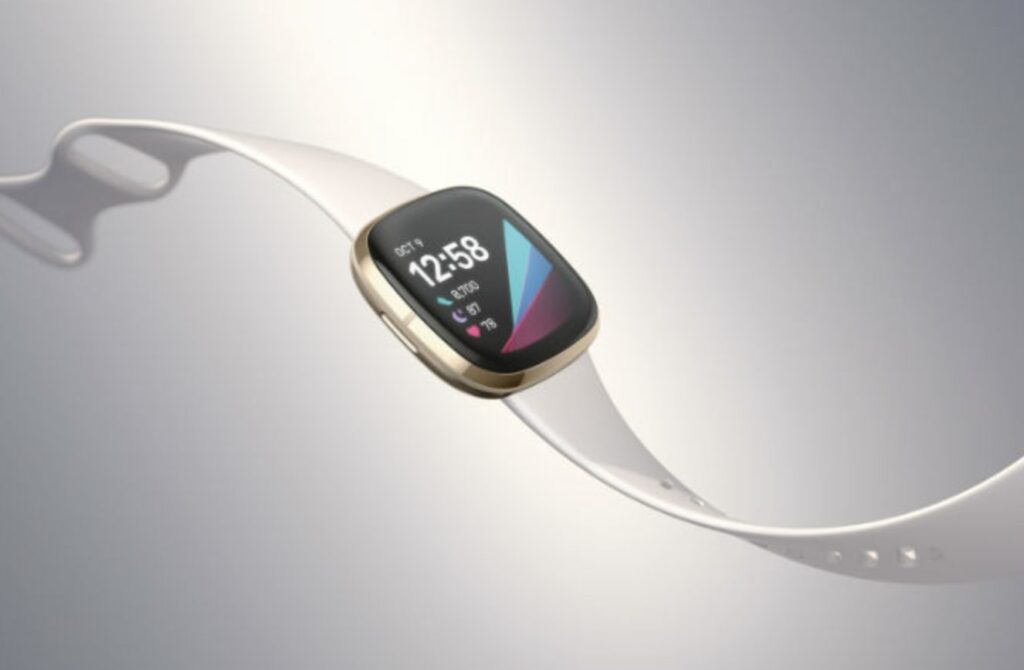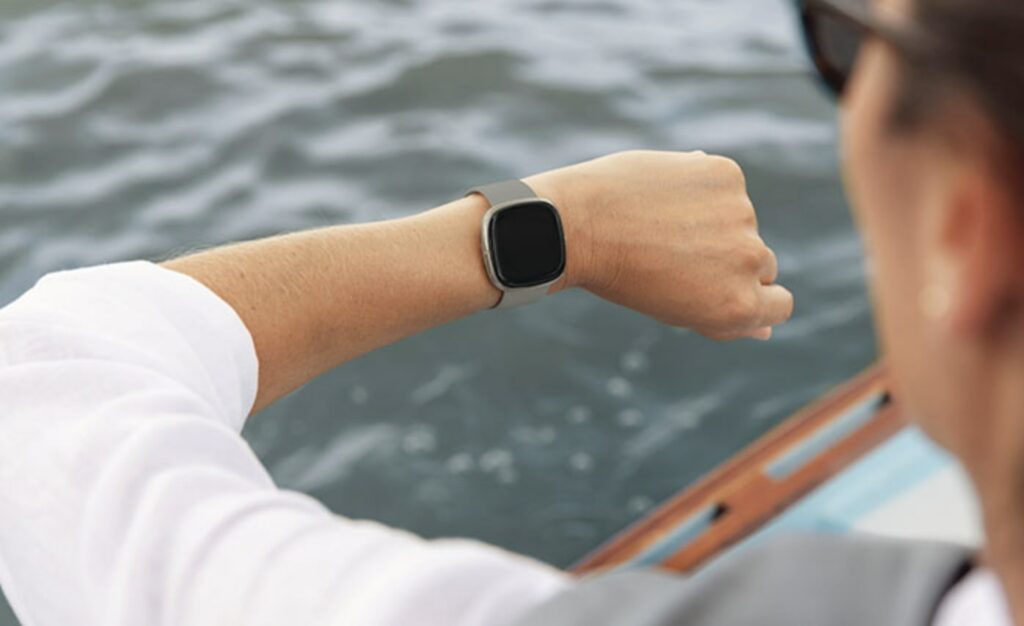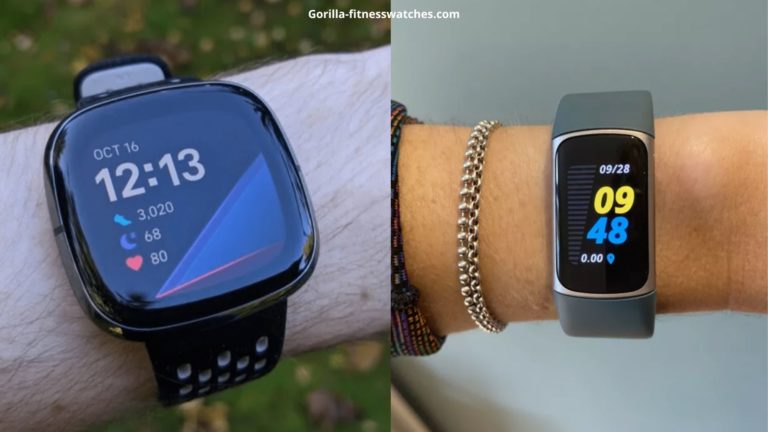Perhaps you’re planning to get a new Fitbit and probably thinking of Fitbit Charge 5 and Sense. Both of these are high-end variants offering almost similar features.
Excluding the design, most fitness features are the same in Fitbit Charge 5 and Sense, like ECG, SpO2, Active Zone Minutes, sleep tracking etc. Even the Fitbit Charge 5 has integrated GPS.
The few minor differences between Charge and Sense makes the one a superior fitness tracker. Keep on reading to know which one is suitable for you.
Fitbit Charge 5 VS Fitbit Sense
1- Design

Fitbit manufactures identical fitness trackers having lightweight. Fitbit Charge 5 follows the design of its predecessor with a slight difference in the bezel.
The beautiful Aluminum bezel makes Charge 5 look like a piece of jewelry or bracelet.
Whereas Fitbit Sense has a squarish design housed in a stainless steel case. So if you’re a fan of smartwatches, you can opt for Fitbit Sense.
There is a physical button on the side of Sense that helps you to navigate, pause, and stop activities. Whereas Fitbit Charge 5 has no physical button.
Comfort-wise, I’m a fan of the Fitbit Charge 5, as it looks more sleek and lighter on the wrist. Charge 5 only weighs 28g throughout the night, and it won’t irritate your wrist during workouts.
Whereas the Fitbit Sense has 45g of weight, it’s not too weighty!
Both Fitbits have a 5 ATM water rating, and you can swim, bath, or shower with them.
Fitbit Charge 5 and Sense both include flexible interchangeable silicone bands to provide maximum comfort.
In a nutshell, if you’re a fan of lightweight and comfortable fitness trackers, look no further than Charge 5. And it has an additional color option to choose from.
Related Post: FITBIT SENSE 2 VS CHARGE 5
2- Display

A big advantage is having an AMOLED display on Charge 5 and Sense. You can view your fitness stats with a glimpse of the outdoors.
Fitbit Sense has a 1.58″ AMOLED display, whereas Charge 5 has a 1.04″ AMOLED display. Both trackers feature Always on Display, which is a big plus.
The Fitbit Sense has a pixel density of 339 ppi which is superior to Charge 5 326 PPI density.
Hats off to Fitbit Sense’s user-friendly layout; you can easily find the app because of the big screen. Where as on Fitbit Charge 5, you have to scroll more.
3- Fitness Features

If you’re a fitness nerd, stay stuck with this section. The real battle starts between the fitness traits of Charge 5 VS Sense.
Fitbit has introduced some of the top-notch features in Charge 5, making it a big competitor to Sense. Now you will find the ECG and EDA scan apps in Fitbit Charge 5.
Both Fitbit wearables have heart rate sensors that measure heat variations, HR, blood oxygen saturation, and heart rate alterations.
Both Fitbits show a daily readiness score for well-disciplined athletes that lets you know when your body is recovering and ready for the next workout session.
The plus point of the Fitbit Charge 5 is that it will show your cardio fitness score based on your VO2 max performance, a valuable feature for cardio lovers, where there are no such features in Fitbit Sense.
The sleep tracking feature in Charge 5 and Fitbit Sense is almost the same, measuring the sleep stages, bedtime, awake time etc.
The Fitbit Sense shows a more detailed overview of your health, and you can put your daily nutrition intake and more.
Alas, there is no temperature sensor in the Fitbit Charge 5, so you will be deprived of tracking your body’s temperature. Sense allows you to monitor your skin temperature variation during the night.
Charge 5 and Fitbit Sense offer 20 sports modes, so you can track your various activities manually. And built-in GPS in both Fitbits tracks your distance, speed, and pace and provides navigation.
4- Smart Features

Being a smartwatch, Fitbit Sense includes many more smart features than the Charge 5.
The built-in speaker and microphone in Fitbit Sense allow you to answer calls directly from the wrist. You can even reply to text messages.
On Fitbit Charge 5, you can only see the notifications and can’t reply to them.
The Built-in Alexa voice assistant in Fitbit Sense is really fun, and you can ask questions, control smart home devices, check the weather, set alarms, and do all the fun with just one voice command.
If you’re a music fan, you will find a Fitbit Sense useful option because it has a dedicated music app and streams music from Spotify and Deezer. Whereas Charge 5 has no music features.
Finally, Fitbit Charge 5 and Fitbit Sene offer Fitbit pay, so you can make contactless payments at the cashier desk.
5- Battery Life
There is no significant difference between the battery performance of Fitbit Sense and Charge 5. Both wearables offer 6+ days of battery backup on a single charge.
Both Fitbits support Qi wireless charging, so you can charge them using any portable wireless charger. You might think about how long both Fitbits take to fully charge, and by change, it’s also the same.
So there is no win or lose between Fitbit Sense Vs Charge 5 in the battery department.
6- Price
Fitbit keeps the baseline of prices low as compared to competitors. But it doesn’t mean that they compromise on quality.
Fitbit Charge 5 and Sense are top-notch variants of their families, so their prices might be higher than other Fitbits.
The Fitbit Charge 5 is available for $129, whereas Fitbit Sense ranges from $140 to $170. Both these Fitbits are still more cost-effective than Apple Watch or Garmin.
Fitbit Charge 5 VS Sense: Which One To Choose
In terms of design and comfort, Charge 5 is the clear winner. Whereas when it comes to smart features like answering calls, voice assistance, and a bigger display, you can opt for Fitbit Sense.
The fitness and health features are pretty much seminary in Fitbit Sense and Charge 5. Because of the larger display, Sense shows a more detailed overview of your health data. On Charge 5, you have to swipe more to get the data.

